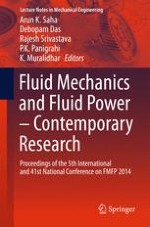This volume comprises the proceedings of the 42nd National and 5th International Conference on Fluid Mechanics and Fluid Power held at IIT Kanpur in December, 2014.The conference proceedings encapsulate the best deliberations held during the conference. The diversity of participation in the conference, from academia, industry and research laboratories reflects in the articles appearing in the volume.
This contributed volume has articles from authors who have participated in the conference on thematic areas such as Fundamental Issues and Perspectives in Fluid Mechanics; Measurement Techniques and Instrumentation; Computational Fluid Dynamics; Instability, Transition and Turbulence; Turbomachinery; Multiphase Flows; Fluid‐Structure Interaction and Flow‐Induced Noise; Microfluidics; Bio‐inspired Fluid Mechanics; Internal Combustion Engines and Gas Turbines; and Specialized Topics.
The contents of this volume will prove useful to researchers from industry and academia alike.
